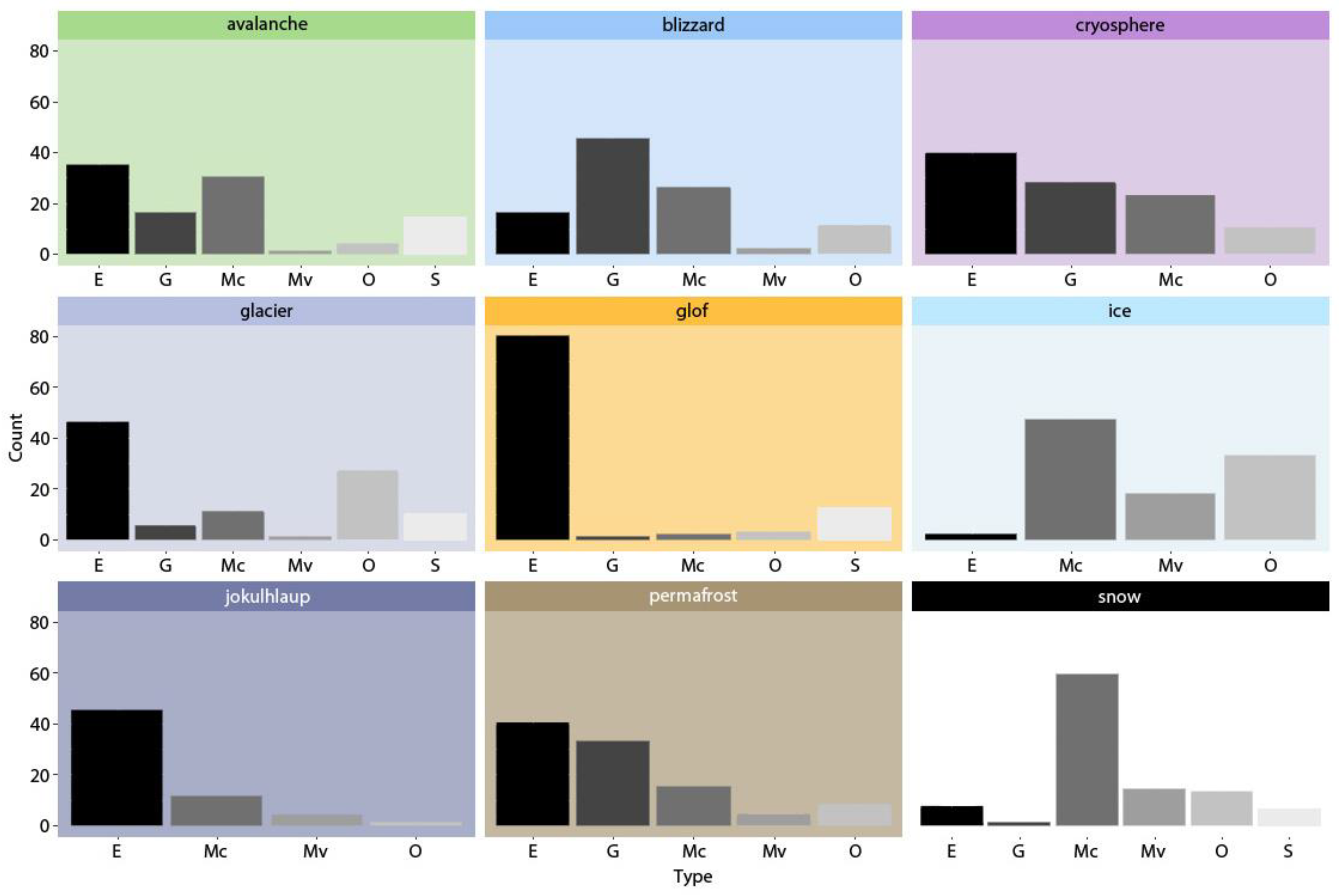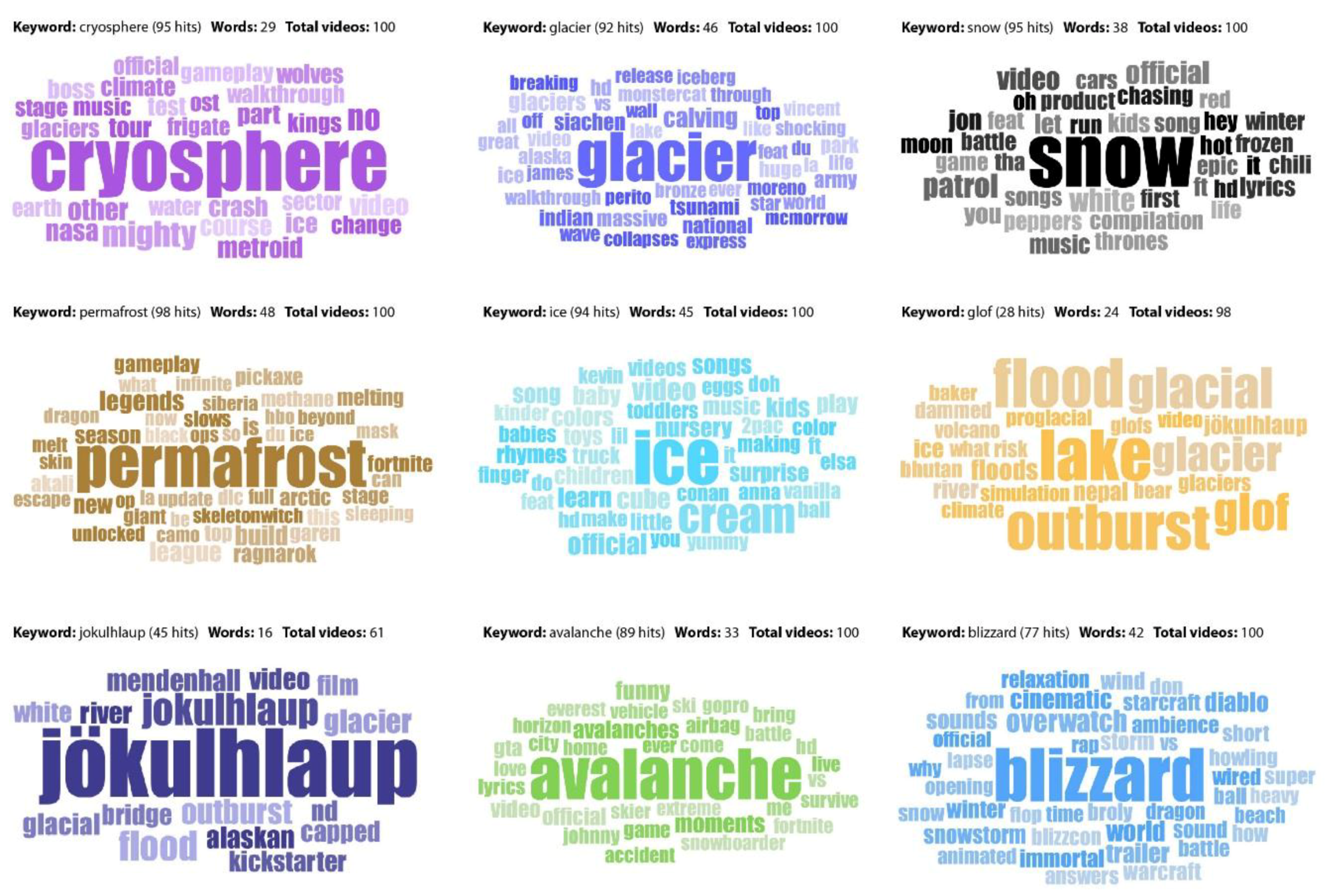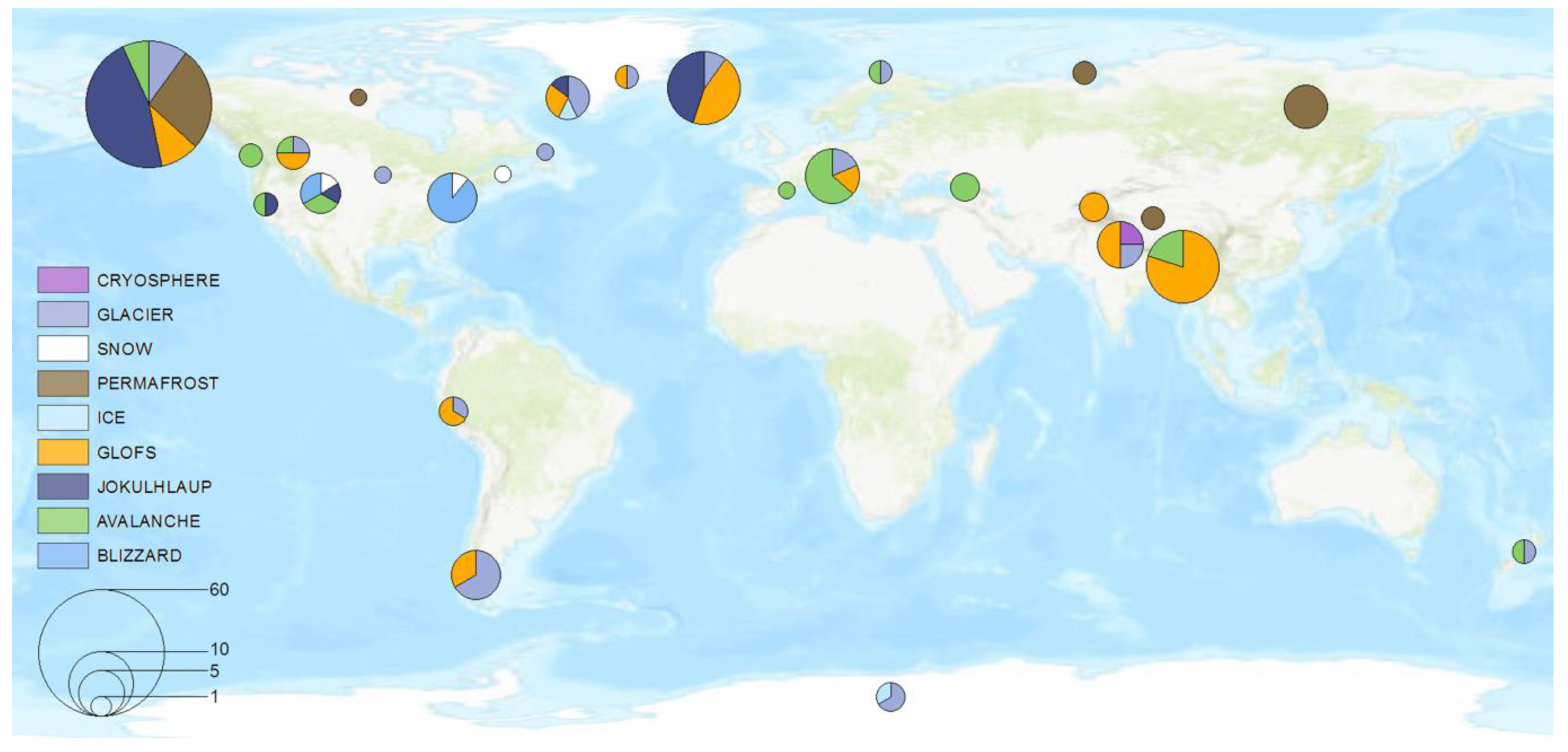The Top-Viewed Cryosphere Videos on YouTube: An Overview
Abstract
:1. Introduction
2. Materials and Methods
2.1. Keywords Definition and Database Building
2.2. Database Analysis and the Structure
3. The Top-Viewed Cryosphere Videos on YouTube
3.1. The Top-Viewed Videos Containing Cryosphere Keywords
3.1.1. General Characteristics of the Dataset
3.1.2. Music, Gaming, Sports Videos and Movies
3.2. The Top-Viewed Videos with Cryospheric Content
3.2.1. The Most Popular Cryosphere Components and Phenomena
3.2.2. Geographical Distribution
3.3. The Top-Viewed Videos about Cryospheric Hazards
3.3.1. Avalanche and Blizzard
3.3.2. Glacial Lake Outburst Floods (GLOFs) and Jokulhlaups
4. Discussion and Outlook
4.1. Potential of YouTube Videos for Educational and Research Purposes
4.1.1. Educational Purposes
4.1.2. Research Purposes
4.2. The Relationship between Views, Likes, Dislikes and Subscribers
4.3. Outlook
Supplementary Materials
Author Contributions
Funding
Acknowledgments
Conflicts of Interest
References
- Intergovernmental Panel on Climate Change (IPCC). Contribution of Working Group I to the Fifth Assessment Report of the Intergovernmental Panel on Climate Change; Cambridge University Press: Cambridge, UK; New York, NY, USA, 2013; 1522p. [Google Scholar]
- Huss, M.; Bookhagen, B.; Huggel, C.; Jacobsen, D.; Bradley, R.S.; Clague, J.J.; Vuille, M.; Buytaert, W.; Cayan, D.R.; Greenwood, G.; et al. Toward mountains without permanent snow and ice. Earths Future 2017, 5, 418–435. [Google Scholar] [CrossRef] [Green Version]
- Rogelj, J.; den Elzen, M.; Hohne, N.; Fransen, T.; Fekete, H.; Winkler, H.; Chaeffer, R.S.; Ha, F.; Riahl, K.; Meinshausen, M. Paris Agreement climate proposals need a boost to keep warming well below 2 degrees C. Nature 2015, 534, 631–639. [Google Scholar] [CrossRef] [PubMed]
- Roe, G.H.; Baker, M.B.; Herla, F. Centennial glacier retreat as categorical evidence of regional climate change. Nat. Geosci. 2017, 10, 95. [Google Scholar] [CrossRef]
- Screen, J.A. Cryosphere Arctic sea ice at 1.5 and 2 degrees C. Nat. Clim. Chang. 2018, 8, 362–363. [Google Scholar] [CrossRef]
- Garavaglia, V.; Diolaluti, G.; Smiraglia, C.; Pasquale, V.; Pelfini, M. Evaluating tourist perception of environmental changes as a contribution to managing natural resources in glacierized areas: A case study of the forni glacier (Stelvio National Park, Italian Alps). Environ. Manag. 2012, 50, 1125–1138. [Google Scholar] [CrossRef] [PubMed]
- Deng, M.Z.; Qin, D.H.; Zhang, H.G. Public perceptions of climate and cryosphere change in typical arid inland river areas of China: Facts, impacts and selections of adaptation measures. Quat. Int. 2012, 282, 48–57. [Google Scholar] [CrossRef]
- Xiao, C.-D.; Wang, S.J.; Qin, D.H. A preliminary study of cryosphere service function and value evaluation. Adv. Clim. Chang. Res. 2015, 6, 181–187. [Google Scholar] [CrossRef]
- Demiroglu, O.C.; Dannevig, H.; Aall, C. Climate change acknowledgement and responses of summer (glacier) ski visitors in Norway. Scand. J. Hosp. Tour. 2018, 18, 419–438. [Google Scholar] [CrossRef]
- Chaudhary, P.; Rai, S.; Wangdi, S.; Mao, A.; Rehman, N.; Chettri, S.; Bawa, K.S. Consistency of local perceptions of climate change in the Kangchenjunga Himalaya landscape. Curr. Sci. 2011, 101, 504–513. [Google Scholar]
- Anderegg, W.R.L.; Goldsmith, G.R. Public interest in climate change over the past decade and the effects of the ‘climategate’ media event. Environ. Res. Lett. 2014, 9, 054005. [Google Scholar] [CrossRef] [Green Version]
- Gioli, G.; Khan, T.; Scheffran, J. Climatic and environmental change in the Karakoram: Making sense of community perceptions and adaptation strategies. Reg. Environ. Chang. 2014, 14, 1151–1162. [Google Scholar] [CrossRef]
- Bury, J.T.; Mark, B.G.; McKenzie, J.M.; French, A.; Baraer, M.; Huh, K.I.; Luyo, M.A.Z.; Lopez, R.J.G. Glacier recession and human vulnerability in the Yanamarey watershed of the Cordillera Blanca, Peru. Clim. Chang. 2011, 105, 179–206. [Google Scholar] [CrossRef]
- Jurt, C.; Burga, M.D.; Vicuna, L.; Huggel, C.; Orlove, B. Local perceptions in climate change debates: Insights from case studies in the Alps and the Andes. Clim. Chang. 2015, 133, 511–523. [Google Scholar] [CrossRef]
- Vuille, M.; Carey, M.; Huggel, C.; Buytaert, W.; Rabatel, A.; Jacobsen, D.; Soruco, A.; Villacis, M.; Yarleque, C.; Elison Timm, O.; et al. Rapid decline of snow and ice in the tropical Andes—impacts, uncertainties and challenges ahead. Earth Sci. Rev. 2018, 176, 195–213. [Google Scholar] [CrossRef]
- Gagne, K.; Rasmussen, M.B.; Orlove, B. Glaciers and society: Attributions, perceptions, and valuations. Wiley Interdiscip. Rev. Clim. Chang. 2014, 5, 793–808. [Google Scholar] [CrossRef]
- Allison, E.A. The spiritual significance of glaciers in an age of climate change. Wiley Interdiscip. Rev. Clim. Chang. 2015, 6, 493–508. [Google Scholar] [CrossRef]
- Scoville-Simonds, M. Climate, the earth, and god–Entangled narratives of cultural and climatic change in the Peruvian Andes. World Dev. 2018, 110, 345–359. [Google Scholar] [CrossRef]
- Buytaert, W.; Zulkafli, Z.; Grainger, S.; Acosta, L.; Alemie, T.C.; Bastiaensen, J.; De Bièvre, B.; Bhusal, J.; Clark, J.; Dewulf, A.; et al. Citizen science in hydrology and water resources: Service management and suitable development. Frontiers Earth Sci. 2014, 2, 26. [Google Scholar] [CrossRef]
- Schnebele, E.; Cervone, G. Improving remote sensing flood assessment using volunteered geographical data. Nat. Hazards Earth Syst. Sci. 2013, 12, 669–677. [Google Scholar] [CrossRef]
- Newman, G.; Wiggins, A.; Crall, A.; Graham, E.; Newman, S.; Crowston, K. The future of citizen science: Emerging technologies and shifting paradigm. Front. Ecol. Environ. 2012, 10, 298–304. [Google Scholar] [CrossRef]
- Pasquali, M. Video in science. Protocol videos: The implications for research and society. EMBO Rep. 2007, 8, 712–716. [Google Scholar] [CrossRef]
- Clarivate Analytics Web of Science. Available online: www.webofknowledge.com (accessed on 27 March 2019).
- Duncan, I.; Yarwood-Ross, L.; Haigh, C. YouTube as a source of clinical skills education. Nurse Educ. Today 2013, 33, 1576–1580. [Google Scholar] [CrossRef] [PubMed]
- Eusden, J.D.; Duval, M.; Bryant, M. Google earth mashup of the geology in the presidential range, New Hampshire: Linking real and virtual fieldtrips for an introductory geology class. Geol. Soc. Am. 2012, 492, 355–366. [Google Scholar]
- Elwood, S.; Goodchild, M.F.; Sui, D.Z. Researching volunteered geographic information: Spatial data, geographic research, and new social practice. Ann. Assoc. Am. Geogr. 2012, 102, 571–590. [Google Scholar] [CrossRef]
- Assumpção, T.H.; Popescu, I.; Jonoski, A.; Solomatine, P. Citizen observations contributing to flood modelling: Opportunities and challenges. Hydrol. Earth Syst. Sci. 2018, 22, 1473–1489. [Google Scholar] [CrossRef]
- Goodchild, M.F. Citizens as sensors: The world of volunteered geography. GeoJournal 2007, 69, 211–221. [Google Scholar] [CrossRef]
- Kobori, H.; Dickson, J.L.; Washitani, I.; Sakurai, E.; Amano, T.; Komatsu, N.; Kitamura, W.; Takagawa, S.; Kozoma, K.; Ogawara, T.; et al. Citizen science: A new approach to advance ecology, education, and conservation. Ecol. Res. 2016, 31, 1–19. [Google Scholar] [CrossRef]
- El Bizri, H.R.; Mocatty, T.Q.; Lima, J.J.S.; Valsecchi, H. The trill of the chase: Uncovering illegal sport hunting in Brazil through YouTubeTM posts. Ecol. Soc. 2015, 20, 30. [Google Scholar] [CrossRef]
- Silvertown, J. A new dawn for citizen science. Trends Ecol. Evol. 2009, 24, 467–471. [Google Scholar] [CrossRef]
- Tang, Z.; Zhang, L.; Xu, F.; Vo, H. Examining the role of social media in California’s draught risk management in 2014. Nat. Hazards 2015, 79, 171–193. [Google Scholar] [CrossRef]
- Amato, A.; Arcoraci, L.; Casarotti, E.; Di Stefano, R. The INGVterremoti channel on YouTube. Ann. Geophys. 2012, 55, 403–408. [Google Scholar]
- Lang, N.P.; Land, K.T.; Camodeca, B.M. A geology-focused virtual fieldtrip to Tenerife, Spain. Geol. Soc. Am. 2012, 492, 323–334. [Google Scholar]
- Klonner, C.; Marx, S.; Usón, T.; de Albuquerque, J.P.; Höfle, B. Volunteered geographic information in natural hazard analysis: A systematic literature review of current approaches with a Focus on preparedness and mitigation. ISPRS Int. J. Geo Inf. 2016, 5, 103. [Google Scholar] [CrossRef]
- Heipke, C. Crowdsourcing geospatial data. ISPRS J. Photogramm. Remote Sens. 2010, 65, 550–557. [Google Scholar] [CrossRef]
- MDPI. Special Issue Cryosphere II; MDPI: Basel, Switzerland, 2018; p. 1. [Google Scholar]
- Emmer, A. Geographies and scientometrics of research on natural hazards. Geosciences 2018, 8, 382. [Google Scholar] [CrossRef]
- MAXQDA 2018.2. Professional Software for Qualitative & Mixed Methods Research. The Art of Data Analysis. Available online: www.maxqda.com (accessed on 27 March 2019).
- McGee, R.G.; Craig, J.C. What is being published? A word cloud of titles from the journal of paediatrics and child health. J. Paediatr. Child Health 2012, 48, 452. [Google Scholar] [CrossRef]
- Li, D.Y.; Zhou, X.L. “Leave your footprints in my words”-A georeferenced word-cloud approach. Environ. Plan. A 2017, 49, 489–492. [Google Scholar] [CrossRef]
- Atenstaedt, R. Word cloud analysis of the BJGP: 5 years on. Br. J. Gen. Pract. 2017, 67, 231–232. [Google Scholar] [CrossRef] [Green Version]
- Schwarz, C.; Debruyne, R.; Kuch, M.; McNally, E.; Schwarcz, H.; Aubrey, A.D.; Bada, J.; Polnar, H. New insights from old bones: DNA preservation and degradation in permafrost preserved mammoth remains. Nucleic Acids Res. 2009, 37, 3215–3229. [Google Scholar] [CrossRef] [Green Version]
- Goda, G.; Pokhrel, R.M.; Katagiri, T.; Chiaro, G.; Kiyota, T.; Sharma, K.; Wilkinson, S. The 2015 gorkha Nepal earthquake: Insights from earthquake damage survey. Front. Built Environ. 2015, 1, 8. [Google Scholar] [CrossRef]
- Kargel, J.S.; Leonard, G.J.; Shugar, D.H.; Haritashya, U.K.; Bevington, A.; Fielding, E.J.; Fujita, K.; Geertsema, M.; Miles, E.S.; Steiner, J.; et al. Geomorphic and geologic controls of geohazards induced by Nepal’s 2015 Gorkha earthquake. Science 2016, 351, aac8353. [Google Scholar] [CrossRef]
- Carrivick, J.L.; Turner, A.G.D.; Russell, A.J.; Ingeman-Nielsen, T.; Yde, J.C. Outburst flood evolution at Russell Glacier, western Greenland: Effects of a bedrock channel cascade with intermediary lakes. Quat. Sci. Rev. 2013, 67, 39–58. [Google Scholar] [CrossRef]
- Byers, A.C.; McKinney, D.C.; Somos-Valenzuela, M.; Watanabe, T.; Lamsal, D. Glacial lakes of the Hinku and Hongu valleys, Makalu Barun National Park and Buffer Zone, Nepal. Nat. Hazards 2013, 69, 115–139. [Google Scholar] [CrossRef]
- Wilcox, A.C.; Wade, A.A.; Evans, E.G. Drainage events from a glacier–dammed lake, Bear Glacier, Alaska: Remote sensing and field observations. Geomorphology 2014, 220, 41–49. [Google Scholar] [CrossRef]
- Emmer, A. GLOFs in the WOS: Bibliometrics, geographies and global trends of research on glacial lake outburst floods (Web of Science, 1979–2016). Nat. Hazards Earth Syst. Sci. 2018, 18, 813–827. [Google Scholar] [CrossRef]
- Shoufan, A. Estimating the cognitive value of YouTube’s educational videos: A learning analytics approach. Comput. Hum. Behav. 2019, 92, 450–458. [Google Scholar] [CrossRef]
- Keelan, J.; Pavri-Garcia, V.; Tomlinson, G.; Wilson, K. YouTube as a source of information on immunization: A content analysis. JAMA J. Am. Med. Assoc. 2007, 298, 2482–2484. [Google Scholar] [CrossRef]
- Steinberg, P.L.; Wason, S.; Stern, J.M.; Deters, L.; Kowal, B.; Seigne, J. YouTube as source of prostate cancer information. Urology 2010, 75, 619–622. [Google Scholar] [CrossRef]
- Jaffar, A.A. YouTube: An emerging tool in anatomy education. Anat. Sci. Educ. 2012, 5, 158–164. [Google Scholar] [CrossRef]
- Lewis, Q.W.; Park, E. Volunteered geographic videos in physical geography: Data mining from YouTube. Ann. Am. Assoc. Geogr. 2018, 108, 52–70. [Google Scholar] [CrossRef]
- Vosoughi, S.; Roy, D.; Aral, S. The spread of true and false news online. Science 2018, 359, 1146. [Google Scholar] [CrossRef]
- Brainard, J. YouTube clarifies science videos. Science 2018, 361, 629. [Google Scholar]
- Goudie, A.S. Aesthetics and relevance in geomorphological outreach. Geomorphology 2002, 47, 245–249. [Google Scholar] [CrossRef]
- Krajewski, J.M.T.; Schumacher, A.C.; Dalrymple, K.E. Just turn on the faucet: A content analysis of PSAs about the global water crisis on YouTube. Environ. Commun. 2019, 13, 255–275. [Google Scholar] [CrossRef]
- Le Boursicaud, R.; Pénard, L.; Hauet, A.; Thollet, F.; Le Coz, J. Gauging extreme floods on YouTube: Application of LSPIV to home movies for the post-event determination of stream discharges. Hydrol. Process. 2015, 30, 90–105. [Google Scholar] [CrossRef]
- Emmer, A.; Vilímek, V.; Huggel, C.; Klimeš, J.; Schaub, Y. Limits and challenges to compiling and developing a database of glacial lake outburst floods. Landslides 2016, 16, 1579–1584. [Google Scholar] [CrossRef]
- Carrivick, J.L.; Tweed, F.S. A global assessment of the societal impacts of glacier outburst floods. Glob. Planet. Chang. 2016, 144, 1–16. [Google Scholar] [CrossRef] [Green Version]
- Mergili, M.; Emmer, A.; Juřicová, A.; Cochachin, A.; Fischer, J.-T.; Huggel, C.; Pudasaini, S.P. How well can we simulate complex hydro-geomorphic process chains? The 2012 multi-lake outburst flood in the Santa Cruz Valley (Cordillera Blanca, Perú). Earth Surf. Process. Landf. 2018, 43, 1373–1389. [Google Scholar] [CrossRef]
- Tahamatan, I.; Afshar, A.S.; Ahamdzadekh, K. Factors affecting number of citations: A comprehensive review of the literature. Scientometrics 2016, 107, 1195–1225. [Google Scholar] [CrossRef]
- Khan, G.F.; Vong, S. Virality over YouTube: An empirical analysis. Internet Res. 2014, 24, 629–647. [Google Scholar] [CrossRef]





| Characteristic | Description | Values |
|---|---|---|
| Title | Title of the video | 843 unique titles (a total of 859 videos) |
| Author | Name of YouTube channel | 661 unique YouTube channels |
| Subscribers | Total of channel’s subscribers | 0 to 66 M subscribers of the channel |
| Length | Duration of the video (h:m:s) | 0:00:04 to 10:00:10 |
| Date published | Date of appearance on YouTube | 4.3.2006–12.2.2019 |
| Days since published | Difference between Date published and the date of analysis (in days) | 10–4720 days |
| Views | Total views at the date of database building | 2–1.6B views |
| Views per day | An average number of views per day | 0.007–4,500,000 views per day |
| Likes | Total of likes (thumbs up) | 0–16M |
| Dislikes | Total of dislikes (thumbs down) | 0–761,000 |
| Type | Qualitative description of the content (6 categories) | (i) video with cryospheric content; (ii) music video; (iii) movie; (iv) gaming video; (v) sport video; (vi) other |
| Cryosphere keyword | Cryospheric keyword used in the search (9) | (i) cryosphere; (ii) glacier; (iii) ice; (iv) permafrost; (v) snow; (vi) avalanche; (vii) blizzard; (viii) glacial lake outburst flood; (ix) jokulhlaup |
| Geographical focus 1 | Location where the video has been shot | 27 locations/hotspots in 17 different countries |
| Title | Author | Published | Views | Views Per Day |
|---|---|---|---|---|
| Keyword: cryosphere | ||||
| NASA | A Tour of the Cryosphere 2009 | NASA Goddard | 2009 | 172k | 49.9 |
| NASA | A Short Tour of the Cryosphere | NASA Goddard | 2007 | 54k | 12.3 |
| NASA Explorers: Cryosphere—The Big Thaw | NASA | 2018 | 27k | 254.7 |
| Keyword: glacier | ||||
| “CHASING ICE” captures largest glacier calving ever filmed—OFFICIAL VIDEO | Exposure Labs | 2012 | 55M | 24,641.6 |
| Glacier Calving, Huge Wave | rqmondo | 2010 | 6.8M | 2149.9 |
| Glacier bridge collapses in Perito Moreno || Viral Video UK | ViralVideoUK | 2016 | 6.6M | 6451.6 |
| Keyword: ice | ||||
| “CHASING ICE” captures largest glacier calving ever filmed—OFFICIAL VIDEO | Exposure Labs | 2012 | 55M | 24,641.6 |
| Top 10 Mysterious Things Found Frozen In Ice Antarctica | Top-5 Top-10 | 2017 | 25M | 55,309.7 |
| Keyword: permafrost | ||||
| Los 5 Hallazgos bajo el Hielo mas Increíbles de la Historia | EnigmaCinco | 2016 | 3.7M | 3843.2 |
| 14 Most Amazing Permafrost Discoveries from Siberia | Extinction Blog | 2017 | 1.0M | 2421.3 |
| The Permafrost Mystery: scientists explore giant Yamal Sinkhole | RT Documentary | 2015 | 950k | 787.1 |
| Keyword: snow | ||||
| Amtrak Snow-mo Collision | Nick Colvin | 2017 | 17M | 24,602.0 |
| Frozen Fails | An Epic Snow and Ice Fail Compilation by FailArmy | FailArmy | 2015 | 15M | 10,259.9 |
| EPIC CATCH!!! Dashing Thru the Snow—CN Train 406 West at Salisbury, NB | containerman2 | 2015 | 14M | 9575.9 |
| Title | Author | Subscribers | Published | Likes | Keyword |
|---|---|---|---|---|---|
| Solo Overnight Camping In Blizzard—70 Subscriber Special | Nickolas Green Outdoors | 282k | 2018 | 253k | blizzard |
| WE ESCAPED AN AVALANCHE! (Raw Footage) | Logan Paul Vlogs | 18M | 2017 | 191k | avalanche |
| Amtrak Snow-mo Collision | Nick Colvin | 11k | 2017 | 132k | snow |
| Top 10 Mysterious Things Found Frozen In Ice Antarctica | Top-5 Top-10 | 180k | 2017 | 131k | ice |
| He Spent 40 Years Alone in the Woods, and Now Scientists Love Him | Short Film Showcase | National Geographic | 10M | 2017 | 119k | snow |
| Avalanche Devours Hikers Within Seconds | Daily Dose of Internet | 5M | 2019 | 108k | avalanche |
| Frozen Fails | An Epic Snow and Ice Fail Compilation by FailArmy | FailArmy | 14M | 2015 | 96k | snow |
| “CHASING ICE” captures largest glacier calving ever filmed—OFFICIAL VIDEO | Exposure Labs | 13k | 2012 | 71k | glacier, ice |
| Beautiful 48 h Time-Lapse of 2016 Blizzard | WorseThanChiggers | 14k | 2016 | 70k | blizzard |
| NYC BLizzard FAILURE | CaseyNeistat | 10M | 2017 | 62k | blizzard |
© 2019 by the authors. Licensee MDPI, Basel, Switzerland. This article is an open access article distributed under the terms and conditions of the Creative Commons Attribution (CC BY) license (http://creativecommons.org/licenses/by/4.0/).
Share and Cite
Emmer, A.; Cuřín, V.; Daněk, J.; Duchková, H.; Krpec, P. The Top-Viewed Cryosphere Videos on YouTube: An Overview. Geosciences 2019, 9, 181. https://doi.org/10.3390/geosciences9040181
Emmer A, Cuřín V, Daněk J, Duchková H, Krpec P. The Top-Viewed Cryosphere Videos on YouTube: An Overview. Geosciences. 2019; 9(4):181. https://doi.org/10.3390/geosciences9040181
Chicago/Turabian StyleEmmer, Adam, Vojtěch Cuřín, Jan Daněk, Helena Duchková, and Petr Krpec. 2019. "The Top-Viewed Cryosphere Videos on YouTube: An Overview" Geosciences 9, no. 4: 181. https://doi.org/10.3390/geosciences9040181
APA StyleEmmer, A., Cuřín, V., Daněk, J., Duchková, H., & Krpec, P. (2019). The Top-Viewed Cryosphere Videos on YouTube: An Overview. Geosciences, 9(4), 181. https://doi.org/10.3390/geosciences9040181






